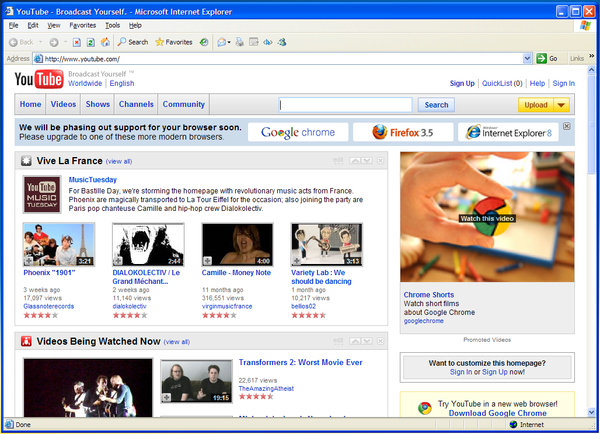

You may just be wondering why it matters. Microsoft have their operating systems on over 90% of the world’s desktops and these just happen to ship with IE as the default browser. Not only that some sites use code specifically designed for Microsoft technologies like Active-X, so why not just take it easy and reap the benefits of interoperability that stem from the dominant browser? Why not just leave Firefox to the geeks and besides “If the guys at Mozilla want to compete they might consider embracing Microsoft-compliant code”.
First let’s get a few facts straight.
- Firefox is simply better: Gecko-based browsers are way ahead of IE6 in their support for XHTML and cascading style sheets. IE7 may have copied tabbed browsing from Opera and Firefox but it hasn’t fully embraced CSS 2.0.
- Firefox is almost infinitely extensible and customisable: Besides RSS feeds, multiple search bars, multi-coloured tabs with progress bars, image zooms, Wysiwyg HTML editors, you can even have a full integrated FTP client, automate the download of whole sites for offline reading, hundreds of themes or skins to choose from and more.
- Firefox blocks unwanted popups: by default Firefox only allows user-activated pop-up windows.
- Firefox does not let in viruses: As the browser shields itself from the operating system and does not use Active-X, you can only install viruses if you run a file that has permission to execute on your computer. This is primarily a problem with Windows, but user stupidity can wreak havoc on any system.
- Firefox lets you resize all text: Many Websites use absolute font sizes that IE will not resize without additional software. In Firefox just press Ctrl/Cmd with + or – to increase or decrease font size.
- Keep everything in one window: With the Tab Mix Plus extension you can easily force all external links to open in a new tab within the same window with tabs spanning multiple rows if necessary. Next time you restart your browser, it will restore your previous browsing session for you.
- What about e-mail integration: If you want an integrated mail client to replace Thunderbird (open-source alternative to MS Outlook), you can always install Sea Monkey with an advanced HTML editor and IRC chat client.
- Microsoft uses older technology: Only sites still using Active-X (which Microsoft is phasing out in IE7 and Windows Vista incidentally) and non-compliant J-Script as opposed to standard Javascript become unworkable in Firefox. There are no special tricks that can only be achieved in IE, only bad coding is responsible. The most notorious sites that caused problems with Firefox last year included http://www.jobcentreplus.gov.uk and http://www.odeon.co.uk . Both have now been upgraded. At one stage users of Yahoo’s Web-mail service could not add rich-text formatting to their emails in Firefox. No longer, Yahoo has made its services Firefox-compatible. As many web designers know, with more sites now relying on style sheets for layout and ditching old in-line markup, you’re more likely to encounter quirks in IE than Firefox. Consider this site, the Tux penguin below the menu has a transparent background in Firefox and Safari, but a appears on a white rectangle in IE.
- Firefox is free and open source: Anyone can download, install and redistribute it. Not only that the source code is publicly available.
So if you still think Firefox is just for Microsoft-bashing nerds, why on earth would the Redmond Giant want to turn its next version of Internet Explorer into Firefox Light with a legacy Microsoft quirks compatibility mode?
Download, install and try it! If you don’t still like it and prefer IE, Safari or Konqueror, simply reset your preferred browser as default. But if you like surfing as much as I do, the only real competition is Opera.
What about Netscape?
Well, it’s still around, but in 1999 AOL bought it and shortly after discontinued independent development of the old 4+ code base, promoting its own branded version of Internet Explorer instead. Back then IE had better support for W3C standards, as Netscape included a number of non-standard enhancements such as layer instead of div tags. User numbers dropped rapidly to under 3% until 2000 when Netscape 6.0 appeared with a beta Gecko engine at a time with few CSS-layout sites. Version 7 saw some improvements, but in an era of almost complete IE domination. The latest offering outsourced to Mercurial Communications but distributed by AOL combines Firefox’s Gecko engine and IE’s Trident engine with a few bells and whistles that you could add to Firefox simply by installing extensions. Moreover, Netscape 8 is only available for Windows XP. Current figures show Firefox with over 10% of browser usage and considerably more in continental Europe with Netscape still under 1% and both Opera and Safari gaining niches between 1% and 3%. However, as of this writing Firefox tends to appeal to heavy users and web developers (just consider the way the Web Developer’s tool bar lets you deconstruct and analyse a Web site), so fewer than 10% of computer users have adopted an alternative to IE. Remember the web is yours and not the sole domain of one multinational corporation.